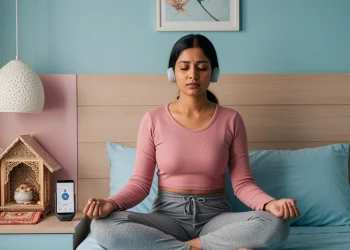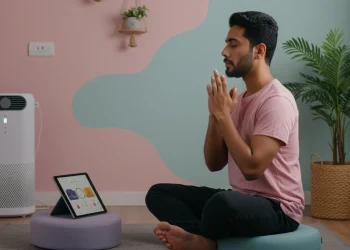Experience the transformative power of ancient Indian sound therapy for deeper, more restorative sleep
Are you struggling to quiet your mind at bedtime? Do racing thoughts keep you awake despite feeling physically exhausted? Traditional Indian sound healing offers a scientifically-backed pathway to peaceful sleep that has been practiced for thousands of years. By combining the wisdom of ancient mantras with modern understanding of sound frequencies, you can create a personalized sleep sanctuary that naturally guides your body and mind into deep rest.
Sound therapy for sleep isn’t just about playing relaxing music—it’s about understanding how specific frequencies, rhythms, and vibrations can synchronize with your brain’s natural sleep cycles. When we explore the rich tradition of Indian music and mantras for sleep, we discover powerful tools that address both the physical and mental barriers to quality rest.
The Science of Sound Frequencies and Sleep
Understanding how sound affects our sleep begins with recognizing that our brains operate on different frequency patterns throughout the day and night. During wakefulness, our brains typically function in beta waves (13-30 Hz), characterized by active thinking and alertness. As we prepare for sleep, these patterns naturally shift toward alpha waves (8-13 Hz), then theta waves (4-8 Hz), and finally delta waves (0.5-4 Hz) during deep sleep.
Sound therapy for sleep works by encouraging this natural progression through a process called brainwave entrainment. When we listen to specific frequencies, our brains tend to synchronize with those rhythmic patterns, gradually shifting from alert beta states to the slower frequencies associated with relaxation and sleep. This phenomenon explains why certain types of music feel inherently calming while others energize us.
Research published in the Journal of Music Therapy demonstrates that listening to music with a tempo of 60-80 beats per minute can significantly reduce the time it takes to fall asleep. These slower rhythms mirror our resting heart rate, creating a physiological response that prepares the body for sleep. Indian classical music, with its emphasis on sustained notes and meditative tempos, naturally aligns with these optimal frequency ranges.
The autonomic nervous system plays a crucial role in this process. When we hear calming sounds, our parasympathetic nervous system—responsible for the body’s “rest and digest” functions—becomes activated. This leads to decreased heart rate, lowered blood pressure, and reduced cortisol levels, all essential components of healthy sleep preparation.
Specific frequencies have been identified as particularly effective for sleep induction. The 432 Hz frequency, often called the “healing frequency,” has been shown to promote relaxation and stress reduction. Many traditional Indian instruments naturally produce tones close to this frequency, which may explain their longstanding association with meditation and peaceful states.
What makes Indian sound healing particularly effective is its understanding of how different ragas (musical scales) affect consciousness. Ancient texts like the Gandharva Veda describe specific ragas designed for different times of day and emotional states. Evening ragas such as Yaman and Bhairavi are specifically composed to induce calmness and prepare the mind for rest.
Traditional Indian Instruments for Deep Relaxation
The rich tapestry of Indian classical music offers numerous instruments specifically suited for creating peaceful sleep environments. Each instrument produces unique tonal qualities and frequencies that can address different aspects of sleep preparation and maintenance.
The sitar, with its complex harmonic structure and sustained resonance, creates an enveloping sound that naturally draws attention inward. Its sympathetic strings produce subtle overtones that continue to vibrate long after the main notes are played, creating a cocoon of sound that helps quiet mental chatter. The gradual decay of sitar notes mirrors the natural process of consciousness settling into deeper states.
Tabla, when played at gentle volumes and slower tempos, provides rhythmic grounding that can help regulate breathing patterns. The deeper bass tones of the tabla support the body’s natural circadian rhythms, while the subtle interplay between the two drums creates a meditative focus that draws attention away from daily stresses.
The santoor’s crystalline tones offer a particularly effective tool for anxiety relief before sleep. Its gentle hammered strings produce pure, bell-like sounds that seem to cleanse mental space. Many listeners report that santoor music helps create a sense of spaciousness in their thoughts, making it easier to let go of the day’s concerns.
Flute music, especially the bansuri, carries frequencies that naturally resonate with the human breath. The instrument’s connection to pranayama (breathing practices) makes it ideal for supporting deep, rhythmic breathing that facilitates sleep onset. The organic, breath-like quality of flute music helps listeners synchronize their own breathing with the musical phrases.
The veena, one of India’s most ancient instruments, produces deeply resonant tones that many practitioners find profoundly calming. Its ability to sustain notes for extended periods creates an almost hypnotic effect that can guide listeners into meditative states conducive to sleep.
Singing bowls, while originally from Buddhist traditions, have been embraced in Indian sound healing practices. Their pure tones and long-lasting vibrations can help clear energetic tension from the body and mind. The gradual fading of bowl tones provides a natural timer for meditation practice before sleep.
Mantra Selection for Different Sleep Issues
Different sleep challenges respond to specific types of mantras, each designed to address particular mental and physical states that interfere with rest. Understanding which mantras work best for your specific sleep issues can dramatically improve their effectiveness.
For racing thoughts and mental restlessness, repetitive mantras with steady rhythms work best. The classic “Om Namah Shivaya” provides a five-syllable pattern that gives the mind just enough complexity to stay engaged while simple enough to become automatic. As you repeat this mantra, either silently or in a whisper, your mind gradually releases its grip on circular thinking patterns.
When anxiety keeps you awake, longer mantras that require sustained attention can be more effective. The Mahamrityunjaya Mantra, though more complex, offers profound comfort for those dealing with fear or worry. Its extended phrases require focused attention, naturally drawing the mind away from anxious thoughts toward the healing vibrations of the sacred sounds.
For those experiencing grief or emotional pain that disrupts sleep, heart-centered mantras like “Om Mani Padme Hum” can provide gentle comfort. This compassion mantra works gradually to soften emotional tension while its six syllables create a breathing rhythm that naturally calms the nervous system.
Physical tension that prevents sleep responds well to body-awareness mantras. “So Hum” (I am) coordinates with natural breathing—”So” on the inhale, “Hum” on the exhale. This simple practice helps release physical holding patterns while connecting consciousness with the natural rhythm of breath.
Sleep disorders related to irregular schedules benefit from mantras that work with specific times of night. The Ratri Suktam, traditionally chanted at sunset, helps establish natural circadian rhythm boundaries. Even listening to recordings of this ancient hymn can signal to your body that the transition to nighttime has begun.
For children or families practicing together, simple seed mantras like “Om” or “Ah” work beautifully. These single-syllable sounds are easy to pronounce and remember, yet their vibrational qualities are profound enough to create genuine relaxation effects.
Creating Your Personalized Sound Environment
Developing an effective personal sound healing practice requires understanding your unique sleep patterns, preferences, and living situation. The goal is creating a consistent audio environment that signals to your body and mind that sleep time has arrived.
Start by observing your current bedtime routine and identifying where sound healing can naturally integrate. Some people find that beginning their sound practice during other evening activities—such as gentle stretching or reading—helps establish the transition more gradually. Others prefer to begin sound therapy only after they’re already in bed with lights dimmed.
Consider your sleep space acoustics when selecting instruments or recordings. Rooms with hard surfaces may benefit from softer, more sustained sounds like flute or singing bowls, while carpeted bedrooms with soft furnishings can handle more complex instrumental arrangements. The goal is creating an enveloping sound environment without overwhelming echo or harsh reflections.
Timing your sound practice involves both duration and progression throughout the session. Many practitioners find that 20-30 minutes provides sufficient time for the nervous system to shift into sleep-ready states. Beginning with slightly more rhythmic or melodic elements and gradually transitioning to simpler, more repetitive sounds mirrors the natural progression from wakefulness to sleep.
Temperature and season considerations affect sound choice as well. Cooler months often call for warmer, more enveloping sounds like sitar or low-pitched chanting, while summer nights may benefit from lighter instruments like flute or higher-pitched singing bowls. This seasonal awareness connects your practice with natural circadian rhythm variations.
Personal preference testing helps identify which specific ragas, instruments, or mantras resonate most strongly with your nervous system. Keep a simple log noting which sounds help you fall asleep more quickly and which lead to deeper, more restful sleep. This information becomes invaluable for refining your practice over time.
Creating backup options ensures your practice remains consistent even when circumstances change. Having both recorded and self-generated options (such as personal mantra practice) means you can maintain your sound healing routine whether you’re at home, traveling, or in shared sleeping spaces.
Volume and Timing Considerations for Optimal Rest
The relationship between sound volume and sleep effectiveness requires careful attention to both physiological responses and practical considerations. Sound that’s too loud can stimulate rather than calm the nervous system, while volumes too soft may not provide sufficient entrainment effects.
Research indicates that sound levels between 40-50 decibels—roughly equivalent to a quiet library or gentle rainfall—provide optimal conditions for sleep-inducing sound therapy. This volume range is loud enough to engage brainwave entrainment while remaining below the threshold that triggers alertness responses. Most smartphones and music players allow precise volume control that can help you identify your personal optimal range.
The timing of volume changes throughout your sleep session plays a crucial role in effectiveness. Beginning at slightly higher volumes (within the therapeutic range) helps establish initial entrainment, while gradually decreasing volume over 15-20 minutes allows natural sleep progression without sudden silence that might cause awakening.
Consider your sleep cycles when planning extended sound sessions. If you choose to play sounds throughout the night, ensure they remain at consistent, very low volumes that won’t disrupt natural sleep stage transitions. Many practitioners find that sounds lasting 60-90 minutes—approximately one complete sleep cycle—provide benefits without risking sleep fragmentation.
Environmental timing involves coordinating your sound practice with household rhythms and external noise patterns. Urban environments with traffic or neighbor activity may require slightly higher therapeutic volumes to mask disruptive sounds, while quiet rural settings allow for very subtle sound levels that work more directly with your nervous system.
Equipment considerations affect both volume control and sound quality. Dedicated speakers designed for meditation or sleep often provide better frequency response at low volumes than standard devices. Some practitioners prefer headphones for precise volume control, though comfort during sleep becomes a factor for side sleepers.
Personal sensitivity varies significantly between individuals and can change based on stress levels, health status, and life circumstances. What works during calm periods may need adjustment during more challenging times. Developing sensitivity to your changing needs ensures your sound practice remains helpful rather than adding stress to your bedtime routine.
Family-Friendly Sound Healing Practices
Introducing sound healing as a family practice creates opportunities for shared relaxation while addressing the diverse sleep needs of different age groups. Children, teens, and adults each respond differently to various sounds, requiring thoughtful selection and adaptation.
For families with young children, simple participatory practices work best. Teaching children to hum along with recorded mantras or creating family “Om” circles before bedtime establishes positive associations with sound and sleep. Children often respond enthusiastically to animal-inspired mantras or nature sounds that connect with their imaginative capacities.
Teenagers facing academic stress or social pressures benefit from sound practices that don’t feel childish yet provide genuine relaxation benefits. Instrumental Indian classical music, particularly pieces featuring sitar or flute, often appeals to adolescent sensibilities while providing therapeutic effects. Allowing teens to participate in selecting family sound healing music increases their engagement and effectiveness.
Couples with different sound preferences can rotate between practices or find compromise solutions that work for both partners. Some couples alternate nights with different instrumental choices, while others find that very simple practices like synchronized breathing with “So Hum” work well for both people simultaneously.
Multi-generational households can benefit from establishing quiet sound zones during evening hours. Playing gentle Indian classical music in common areas during dinner and evening activities helps establish household-wide transitions toward bedtime. Individual practices can then build upon this foundation.
Safety considerations become important when using speakers or devices in children’s bedrooms. Volume limiters, timer functions, and child-safe equipment ensure that sound healing remains beneficial rather than potentially harmful. Teaching children about appropriate volume levels helps them develop healthy relationships with sound therapy.
Creating rituals around family sound practice helps establish consistency and positive associations. This might involve everyone gathering for five minutes of quiet listening, taking turns selecting evening music, or sharing brief reflections about the day before beginning sound meditation.
Integrating Sound Healing into Modern Sleep Routines
Successfully incorporating traditional Indian sound healing into contemporary lifestyles requires balancing ancient wisdom with modern practicalities. The key lies in adapting timeless principles to work within current technology, schedules, and living situations.
Technology can enhance rather than replace traditional practices when used mindfully. High-quality streaming services offer extensive libraries of authentic Indian classical music and mantra recordings. Creating curated playlists that progress from more active ragas to deeply calming ones allows for consistent experiences without requiring extensive musical knowledge.
Smartphone apps designed for meditation and sleep often include Indian mantras and instrumental music, though quality varies significantly. Look for apps that cite their musical sources and offer volume controls, timer functions, and offline access for consistent practice regardless of internet connectivity.
Smart speakers and home automation systems can create seamless integration of sound healing into bedtime routines. Programming these devices to automatically begin playing sleep-inducing ragas at specific times helps establish consistent circadian rhythm cues. Some systems allow gradual volume reduction that mirrors natural sleep onset patterns.
For frequent travelers, maintaining sound healing practices requires portable solutions and adaptability. Noise-canceling headphones designed for sleep can provide consistent sound environments regardless of external conditions. Downloaded music files ensure access to familiar sounds even in areas with poor internet connectivity.
Workplace stress management can benefit from brief sound healing practices during lunch breaks or transition periods. Even five minutes of listening to calming ragas or practicing simple mantras can help reset nervous system activation levels, improving evening wind-down effectiveness.
Social considerations involve communicating with family members, roommates, or neighbors about your sound healing practice. Most people respond positively when they understand the health benefits and peaceful nature of the practice. Establishing reasonable volume levels and time boundaries helps maintain good relationships while supporting your sleep health.
Conclusion: Embracing Ancient Wisdom for Modern Rest
The integration of traditional Indian sound healing into contemporary sleep practices offers a powerful bridge between ancient wisdom and modern sleep science. Through understanding how specific frequencies affect our brainwaves, selecting appropriate instruments and mantras for individual needs, and creating personalized sound environments, we can access profound resources for improving sleep quality naturally.
Sound therapy for sleep provides more than just relaxation—it offers a pathway to deeper connection with our own natural rhythms and healing capacities. Whether you’re drawn to the meditative qualities of sitar music, the rhythmic grounding of gentle tabla, or the transformative power of ancient mantras, these practices invite you into a more peaceful relationship with sleep and rest.
As you begin exploring Indian sound healing for sleep, remember that consistency matters more than perfection. Start with simple practices that appeal to you, gradually building a routine that fits naturally into your lifestyle. Allow yourself time to discover which sounds, volumes, and timing work best for your unique needs.
The journey toward better sleep through sound healing is deeply personal yet connects you with thousands of years of human wisdom about rest, healing, and the transformative power of sacred sound. By embracing these practices, you join a tradition that honors both the practical need for quality sleep and the spiritual dimensions of nighttime restoration.







